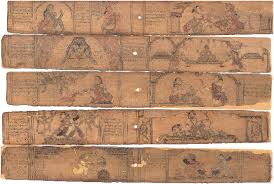Ganita
You are here
Ganita

Mathematics in India has been cultivated in connection with Astronomy. Like the other streams of knowledge, the early references of mathematics, are also found in the vedic literature. The word ‘Rashividya’ is used for mathematics in Chhandogya Upanishad (7.1.2). Some hymns of Shuklayajureda reveal the knowledge of odd numbers and tables (18/24,25). The Brahmana texts like ; ‘ekaya svaha, dvabhyam svaha, tribhyah svaha’ reflect the vedic concept of arithmetical progressions. In Pingal Sutra there is a discourse on the calculation of squares and square roots.
The Indians; earlier than other nations; became familiar with the system of place value of numerals. Undoubtedly the Europian system of enumeration is of Indian origin. India is the birth place of several mathematical concepts including zero, the decimal system, algebra, algorithm, square root and cube root etc. The origin of calculus was in India, even more than three centuries before Leibnitz and Newton introduced their own theorems.
The concept of zero, i.e. shunya, which means ‘void’, a figure to indicate the absence of a position of number is virtually void. A round figure, symbol for zero, i.e. ‘0’ had emerged to represent the philosophical concept of void.
Mathematics in India might have started more than five thousand years ago. Since 1000 B.C. almost for a period of two thousand years, many a number of mathematical works were produced in India. Since the 5th centruay A.D., the method of graduated calculation had been introduced in India. By that time, the geometric theories were known to the Indians. We may see some displays of motifs on the walls of ancient temples. Those motifs ideally reflect the patterns available in Indian architecture, as we see the admixture of floral and wall pattern of geometric method. These concepts, were collected and developed further by the mathematicians like Aryabhata who flourished in the 5th Century A.D. His work Aryabhatiyam is equally important for Mathematics and Astronomy. The first part of the book explains the special system of writing numerals that was introduced by Aryabhata alone. The Second part gives a small anthology of mathematical teachings of Aryabhatta. He deals in his work with evolution and revolution, area and volumes, progressions and algebraic identities.
